skip to main |
skip to sidebar
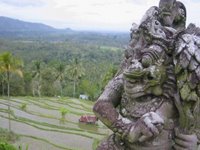 Holiday has come. The beloved holiday. Yes I'm off for a well-deserved holiday, will be going to Indonesia for five weeks.
Holiday has come. The beloved holiday. Yes I'm off for a well-deserved holiday, will be going to Indonesia for five weeks.
Quite unwilling to part from the computer and be isolated away from internet until I come home. Which most probably means that this will be my last blog entry for the next five weeks I will not update until I'm back.Thank you for your patience and continued interest...
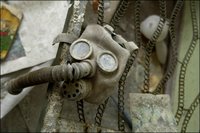 Twenty years ago, on 26th April 1986, reactor number four at the Chernobyl Nuclear Power Plant in Pripyat, Ukraine, which was then part of the Soviet Union exploded. Even today there is still not a consensus on the full impact of the disaster. This was the BBC headline on Monday April 28, 1986: “Soviets admit nuclear accident”.
Twenty years ago, on 26th April 1986, reactor number four at the Chernobyl Nuclear Power Plant in Pripyat, Ukraine, which was then part of the Soviet Union exploded. Even today there is still not a consensus on the full impact of the disaster. This was the BBC headline on Monday April 28, 1986: “Soviets admit nuclear accident”.
From that 1986 BBC article:
“The report was the first confirmation of a major nuclear catastrophe since monitoring stations in Sweden, Finland and Norway began reporting sudden high discharges of radioactivity in the atmosphere two days ago”...
“The sudden jump in radioactivity levels was enough to prompt a full-scale alert in Sweden, which initially believed the accident had happened at its own nuclear power station, on the Baltic coast. The evacuation of 600 workers had been ordered before experts realised that the source of the radioactivity must have been within the Soviet Union”...
2 days after the accident, the Soviets refused to admit something unordinary had occurred until that night when Swedish diplomats gave notice that they were filing an official alert to the International Atomic Energy Authority, Moscow finally issued this statement:
“An accident has occurred at Chernobyl nuclear power station. One of the atomic reactors has been damaged. Measures are being taken to eliminate the consequences of the accident. Aid is being given to the victims. A government commission has been set up”.
Today we commemorate the world’s greatest nuclear accident.Source: BBC
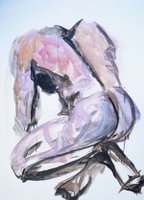 I don't know why I anxiously await the arrival of summer. Perhaps it is a metaphorical reassurance that all things brown and shriveled will come back to life soon.Truth is that I haven't had one inspiration for writing. I'm tired annd drained, but it is just one of those exhausting days as well as physically, mentally, and emotionally.
I don't know why I anxiously await the arrival of summer. Perhaps it is a metaphorical reassurance that all things brown and shriveled will come back to life soon.Truth is that I haven't had one inspiration for writing. I'm tired annd drained, but it is just one of those exhausting days as well as physically, mentally, and emotionally.
Nevertheless, I look forward to the arrival of my holiday and warmer days…
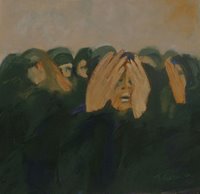 Yesterday my heart is with a family member which has lose his beloved spouse. I can't imagine what he's going through. I've known if someone close to you has died, you may be feeling many different emotions. You may be sad, worried, or scared. You may be numb and you have a certain sense of fear, because everything you have done, you have always done together. You might be shocked, unprepared, or confused. You might be feeling angry, cheated, relieved, guilty, exhausted, or just plain empty.
Yesterday my heart is with a family member which has lose his beloved spouse. I can't imagine what he's going through. I've known if someone close to you has died, you may be feeling many different emotions. You may be sad, worried, or scared. You may be numb and you have a certain sense of fear, because everything you have done, you have always done together. You might be shocked, unprepared, or confused. You might be feeling angry, cheated, relieved, guilty, exhausted, or just plain empty.
It can take time for you to completely accept and adjust to the loss...
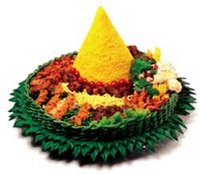 Nasi tumpeng is traditionally served to celebrate a special occasion, like a birthday, a marriage or even success at work. Is a type of food which is made of yellow rice (nasi kuning) and is shaped like a cone. The height of the cone symbolizes the greatness of Allah or God, and the food at the base of the cone symbolize nature’s abundance. The yellow tinge in the rice symbolize wealth and high morals.
Nasi tumpeng is traditionally served to celebrate a special occasion, like a birthday, a marriage or even success at work. Is a type of food which is made of yellow rice (nasi kuning) and is shaped like a cone. The height of the cone symbolizes the greatness of Allah or God, and the food at the base of the cone symbolize nature’s abundance. The yellow tinge in the rice symbolize wealth and high morals.
Nasi kuning is cooked in lightly seasoned coconut milk and turmeric, then shape it into a conical pyramid and place it on a bed of decorated banana leaves. Around the base of the cone, arrange various foods in neat piles: ayam goreng (fried chicken), rendang (beef stew), sambal goreng tempe or kentang (fried tempe or potato), beef abon (shredded meat that has been boiled and fried), telur dadar (shredded egg omelette), cucumber, perkedel kentang (potato cakes), sambal goreng ati ampla (chicken liver and gizzard), and sambal (chili paste).
Normally the host cuts and savors the top of nasi kuning. The touch of oil in the coconut milk gives it a glistening appearance and keeps each grain separate, while turmeric use lends the yellow color to the dish.
Nasi Tumpeng and its side dishes are symbols which have good meanings in Javanese culture...
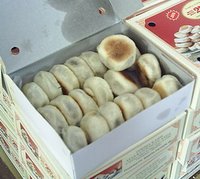 Yogyakarta (also known as “Yogya”) is a special city in Indonesia. It has also a special region status (Daerah Istimewa Yogyakarta - DIY). For tourists, Yogya is probably the second choice of city to visit after Bali.One of Yogjakarta’s specialties is Bakpia.Is a snack which is quite well known in Indonesia. It originated from China. There are several types of bakpia with various fillings such as chocolate, beans, pork, fruits, etc. In Yogyakarta there is one very famous bakpia industry with mungbean filling. This snack which is made from mung beans is a popular souvenir item that domestic Indonesia tourists take home with them.
Yogyakarta (also known as “Yogya”) is a special city in Indonesia. It has also a special region status (Daerah Istimewa Yogyakarta - DIY). For tourists, Yogya is probably the second choice of city to visit after Bali.One of Yogjakarta’s specialties is Bakpia.Is a snack which is quite well known in Indonesia. It originated from China. There are several types of bakpia with various fillings such as chocolate, beans, pork, fruits, etc. In Yogyakarta there is one very famous bakpia industry with mungbean filling. This snack which is made from mung beans is a popular souvenir item that domestic Indonesia tourists take home with them.
Although it is located in the urban center of Yogyakarta, wood stove is still used. According to the producer, the use of wood stove is maintained as it imports a certain flavour to the cake, which is made of mixture of mungbean and sugar. This is then wrapped within a flour-egg dough and placed on a stainless steel sheet and baked in an oven...
 I love eating Tempe, and especially sambel goreng tempe or tempe penyet. Ever wondered about this delicious addition to the meals you buy in Indonesia at the warungs or from the kaki lima?
I love eating Tempe, and especially sambel goreng tempe or tempe penyet. Ever wondered about this delicious addition to the meals you buy in Indonesia at the warungs or from the kaki lima?
Tempe is unique amongst soy foods, is a fermented soybean cake that’s high in B vitamins and valued for its health benefits as well as its nutty. An ever popular and versatile ingredient in Indonesian dishes, it represents a food that has evolved in the archipelago and within Indonesia has become synonymous with Indonesian traditional cookery. Tempe is the soul of village food to the Javanese.In Indonesia, tempe is eaten by all sectors of the population; in villages and cities alike, but because it is cheap and, in Java, easy to find, it is often used as a substitute to meat among the majority of low-income groups. In fact, in a country where meat is expensive and often of dubious quality, tempe is an excellent high protein substitute to meat or fish, without the need for scrupulous hygiene or expensive refrigeration.
If you ask an Indonesian how he prefers his tempe cooked, he would most likely say “tempe goreng”, or deep fried tempe seasoned in garlic, salt and coriander. This is how Indonesians most often prepare tempe, eaten as a side dish to the main meal, a snack, or as a filling meal in itself. In this form it is also often served in the small restaurants or road-side warungs throughout Indonesia as golden-brown bite size pieces of savoury fried tempe, best when still warm and crispy….
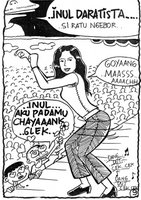 The moment you leave the air of the Soekarno Hatta airport in Jakarta, you’re greeted by a unique mix of tropical heat, the aroma of metropolis city pollution and the tunes of the latest Indonesian pop classic and dangdut music blaring away from the aggressive taxi rank awaiting you outside the terminal.Dangdut, the closest thing Indonesia has produced to the salsa.
The moment you leave the air of the Soekarno Hatta airport in Jakarta, you’re greeted by a unique mix of tropical heat, the aroma of metropolis city pollution and the tunes of the latest Indonesian pop classic and dangdut music blaring away from the aggressive taxi rank awaiting you outside the terminal.Dangdut, the closest thing Indonesia has produced to the salsa.
Is a very popular dance music originally from Indonesia and has spread to neighboring countries such as Malaysia and some parts of the Philippines. The music is lively and has musical influences from different cultures namely Indian, Arabic and of course, Malay. The word “dangdut” is thought to have originated from the dang-dang-dut-dut sound that comes by sound of gendang (small two drums like as bongo) or from the Indian drum “tabla” which gives the music its heartbeat. The rhythm of Dangdut is “shake a body right and left”. The lyrics given to the music are often blatant in issues such as life sufferings, love betrayals, and discontentment towards the political powers that be.
Dangdut’s audience comes mostly from Indonesia’s fervent Muslim youth, in particular the lower and lower-middle classes. And dangdut gives these people a voice, expresses their resentment at the inequalities of life in Indonesia today.
Some folks are fast to give dangdut music a turn of the nose because the music is usually considered old-fashioned, “kampungan” and un-cool. Others are turned off simply by the music’s typically coarse lyrics, underlying political messages and the sexual innuendos suggested by the erotic gyrating that is the signature of dangdut dancing.
Though western pop arrived in Indonesia long ago and is the dominant force, most Indonesian young people still have a healthy smattering of dangdut music in their collection and in their minds. Up to now, in Indonesia, many open-air concerts are held very often and full of more 10.000 audience...
 If you are on holiday in Indonesia, don’t wanna spend to much for transport and if you are communicative, then you must try the public transport or the local transport. They are funny, sometimes they offer wild driving, they can be hot and noisy but still... certainly you come on the spot where you want to. And local people are far from boring. Try it!...
If you are on holiday in Indonesia, don’t wanna spend to much for transport and if you are communicative, then you must try the public transport or the local transport. They are funny, sometimes they offer wild driving, they can be hot and noisy but still... certainly you come on the spot where you want to. And local people are far from boring. Try it!...
Airplane.
Air transport is the easiest and most comfortable means of travel in Indonesia. Air services are available to all provincial and district capitals and other remote areas operated by Garuda Indonesia, Merpati Nusantara, Sempati Air, Bouraq, Mandala Airline and some Low Cost Carriers as Pelita Air, Citilink and Lion Airlines. Garuda Indonesia, the national flag carrier, operates on both international and domestic routes. Domestically it serves more then 30 cities including all the provincial capitals.
Boat.
Not luxurious but comfortable, the ships offer an alternative to flying and is a more leisurely form of travel. If travelling to large islands like Bali, a number of large ferry services operate to other islands in the vicinity.
Train.
Train service is only available through out Java and parts of Sumatra. Several trains run between Jakarta and Surabaya. The most comfortable are the air-conditioned "KA Bima" sleeper train and the "KA Kertajaya" which both travel at night. The "KA Bima" passes through Yogyakarta and Solo, while the "KA Kertajaya" takes the northern route through Semarang. The "KA Fajar/Senja Utama" is an express service to Yogyakarta and Solo. The "KA Parahyangan" offers four services a day between Jakarta and Bandung.
Bus.
The cheapest option but be aware of pickpockets!
Bus services are available and traveling night and day. Many are air-conditioned and have reclining seats as well as TV with video programs. There are numerous bus services between major cities in Java and also limousines which provide door-to-door service.
Taxi.
Taxis can be found in taxi queues (pangkalan) at malls and hotels, or flagged down off the street with a wave of your hand. You can phone the taxi company and they will send a taxi to your home. Metred and unmetred. Many drivers refuse to use (argo)meter. Sometimes meter has been tampered with. If unmetred negotiate before hand.
Mikrolet.
Sometimes called oplet. They are usually employed on tours between city and suburbs and can seat up to 10 passengers per vehicle, sometimes even more than its capacity. Fares are not uniform, as here it does depend on distance covered by the passenger. One advantage over the bus routes is that by using these smaller vehicles you may be let off anywhere you want to, making it a slower vehicle because of its frequent stops.
Angkot.
Minibus Public Transportation or called "Angkot" (ANGkutan KOTa) is a familiar modern transportation in Indonesia. They serve certain routes indicated by the combination of their numbers and their colours, which come in green and blue. These angkots are run by private owners and the prices are fixed.
Bajaj.
Another mode of transport is the Bajaj, orange colored, 3-wheeled scooters, cheaper than taxis. If you take a ride with a bajaj, you must stand with a lot of noise. Bajajs are better for short hops around town, than long distances. Must bargain before getting in.
Bemo.
Blue and brown converted pick-up trucks 10-12 passengers, operate as buses. They have regular routes, but these aren't really written down. Just ask someone where the regular pickup is, and which bemo to take to get you where you want to go. Bemos are better for short hops around town, for example, than long distances. Must bargain before getting in.
Ojek motor.
An Ojek is a motorbike hired with its rider. You may pay him for one single trip or you may hire him for the day, or by the hour. Be sure to bargain beforehand. Ojeks can be found in cities and their suburbs, at intersections or at the mouths of certain side roads.
Ojek sepeda.
Curiously, bicycles at small villages are also used as "Ojek sepeda". For a small fee, the rider is the one who pedals the bike, whereas the passenger hops on the back of it.
Becak.
It is a tricycle pedaled by a man who sits normally behind the passenger. It could seat two persons, however, rather tightly. Becaks are mostly found in cities and towns on Java and have been here for over four decades. Becak can also be used to deliver heavy loads such as fruits and vegetables around pasar (traditional market). Before stepping into a becak, make sure you have bargained before with the becak driver for the agreed upon fare.
Delman.
For leisure means, the traditional horse carriages are available. These are called delman. Not anymore available in Jakarta, but they are still popular in Bogor, Yogyakarta, Solo and Surabaya. They differ in size and shape from place to place as these carts can be two-wheeled or four-wheeled as from the province of Yogyakarta. Here too, bargaining is necessary.
 Bathroom in Bahasa Indonesia is called 'Kamar Mandi'. It can be indoors, in an outside shed like an outhouse, or open-air. It has only two essential components: a concrete or a ceramic-tiled rectangular water basin and a ceramic squat toilet. And, as accessory of course, the all-important plastic-cup-with-handle. it is a simple, elegant system.
Bathroom in Bahasa Indonesia is called 'Kamar Mandi'. It can be indoors, in an outside shed like an outhouse, or open-air. It has only two essential components: a concrete or a ceramic-tiled rectangular water basin and a ceramic squat toilet. And, as accessory of course, the all-important plastic-cup-with-handle. it is a simple, elegant system.
You squat, shit. When done, instead of pressing down on the flush handle, you wash yourself with a cupful of water, then create your own flush (repeat as necessary).
To bathe, just dump some water on yourself with the cup, lather up, then rinse off. There is a drain on the floor so the entire area is used for bathing.
For maintenance one, just scrubs down the floor, the toilet and the basin, then refills the basin.
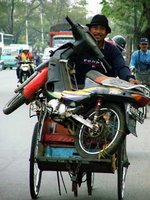 Is this the nowadays trend of transportation by motorcycle in Indonesia since the domestic fuel (BBM) price become more expensive and the fuel subsidies are decreasing? To make it equally, the becak driver should rising increasingly his 'BBM' rate to 500%... :))
Is this the nowadays trend of transportation by motorcycle in Indonesia since the domestic fuel (BBM) price become more expensive and the fuel subsidies are decreasing? To make it equally, the becak driver should rising increasingly his 'BBM' rate to 500%... :))
The Becak
Is one of a unique traditional public transportations in Indonesia. A cycle rickshaw, not powered by an engine, but is a vehicle powered by the driver pedalling as one would a bicycle. Indonesian people take becak when they go to closer places. Besides it is inexpensive and is also guaranteedly pollution-free...Acronym for BBM (Bahan Bakar Minyak) = Fuel
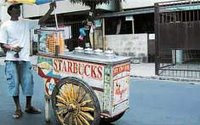 If you want a perfect 'Kopi Tubruk', perhaps you should to use this particular branch of Starbucks somewhere in Jakarta, Indonesia...
If you want a perfect 'Kopi Tubruk', perhaps you should to use this particular branch of Starbucks somewhere in Jakarta, Indonesia...
Kopi Tubruk
The Indonesian way of drinking a strong and sweet coffee, during any time of the day. You will need some very finely ground coffee, sugar, hot water and a tall glass, strong enough to withstand the heat.
Put a tablespoon of coffee in the glass. Add sugar according to taste and pour a bit of hot water on, like you would to prepare hot chocolate. Stir carefully and continue to gently add hot water. Cover the glass and leave the drink for a few minutes so that the coffee can slowly settle on the bottom of the glass.
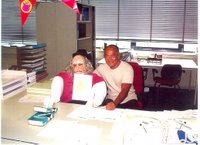 A birthday is the date on which a person was born. It is customary in many cultures to celebrate the anniversary of one's birthday in some way.
A birthday is the date on which a person was born. It is customary in many cultures to celebrate the anniversary of one's birthday in some way.
The Dutch like to celebrate the fact that a person turns fifty. The person in question is the referred to as Abraham (for men) and Sarah (women).
People do all sorts’ of things to surprise the person in a funny way. Some people choose to decorate and place a life size doll with a big sign on the neck saying "Sarah". Others place a large Abraham or Sarah poster on lamp-posts or even on the roof top of buildings. There are plenty of other funny traditions to surprise a person turning 50 with...This old tradition is based upon a story in the bible. It is written that Jesus once said that Abraham had "seen" the day on which Jesus would become the Messiah. Sceptics, however, who first misunderstood and thought that Jesus was saying that he had actually met Abraham himself, said sarcastically, "Not yet fifty years of age, but you have already seen Abraham!"
Hence the tradition in the Netherlands: When you reach the age of fifty you see Abraham or Sarah. It was happened to me in 2000 also. My colleagues surprised me with placing of an Abraham doll on my desk.... :))
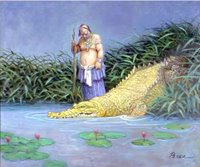 When visiting the Netherlands for the first time, you will probably be struck by the fact that everyone here is quite absorbed with his or her own piece of social space. People don’t immediately speak to strangers, on the trains everyone tries to get a seat where they can sit alone and the foreign visitor soon has the feeling that he or she is being ignored. However, the latter is usually not the case, because when you do address them you'll be surprised at the friendliness of their response.
When visiting the Netherlands for the first time, you will probably be struck by the fact that everyone here is quite absorbed with his or her own piece of social space. People don’t immediately speak to strangers, on the trains everyone tries to get a seat where they can sit alone and the foreign visitor soon has the feeling that he or she is being ignored. However, the latter is usually not the case, because when you do address them you'll be surprised at the friendliness of their response.
The Dutch usually keep their homes very private, so it is a rare treat to be invited into a Dutch home. You may have to know someone for months before he or she actually invites you home. And the Dutch usually do not associate hospitality with food: you will only be invited to eat in a Dutch home after a very long friendship.The Dutch like to keep a certain distance from others, and that is really not so strange in a country that is amongst the most densely populated nations in the world.The Dutch also like to congratulate themselves on their tolerance, but the correct description for this character trait is ‘Live and Let Live’. A sort of: ‘If you leave me alone then I’ll leave you alone’. This way they have fewer conflicts.The Dutch are, above all, pragmatic. Call it pragmatic tolerance. The Dutch appear to be world leaders in the field of progressive attitudes. They always ask themselves what the consequences of their actions may be.
Take prostitution. The Dutch tend to think that it will happen anyway, whether they prohibit it or not. They legalise it, to prevent prostitution from going underground, to have access to the prostitutes, to promote condoms and hygiene and to prevent mistreatment of women forced to work as prostitutes. The logic is simple: ‘tolerate it, rather than prohibit it and subsequently lose control’.
The sale of limited amounts of soft drugs has already been tolerated for years. A Dutch person would think: If soft drugs were forbidden then their use and traffic would go underground and no one could legally control it any longer. Furthermore, the prices would go up, forcing some users into criminal behaviour sooner rather than later. The remedy may be worse than the disease.
Lesbian and gays could officially marry. The senate has approved the legalisation of euthanasia, under strict conditions.
Sex at a young age, is another good example of the same tolerance. Undesirable according to many, but treated pragmatically by the Dutch. Kids will have sex, whether you like it or not. So, at 12 years old, they get education and can go to a clinic to get contraceptives. Anonymously, if they want. Their parents won’t know.
Does this stimulate Dutch adolescents to have sex at a younger age, as critics might claim? No. Dutch youngsters have their first sexual experience relatively late. And more importantly, the number of abortions and unwanted pregnancies among teenagers is the lowest in the world.
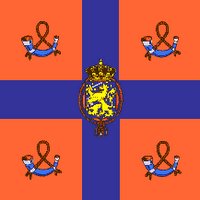 A first impression
A first impression
People who arrive in the Netherlands via Schiphol Airport, get a first impression of the polders, ditches, rivers and cities to be seen from the air. It is a cultivated piece of Western Europe bordering on the North Sea that is called the Netherlands (Nederland).
Most foreigners, however, are far more familiar with the name “Holland”. Holland is the collective name for the two western provinces (North and South Holland), which historically were the two most powerful provinces during the “Golden Age” in the Republic of the Seven United Netherlands of the seventeenth century.
Those who continue their journey from Schiphol by train, will notice that urban and industrial areas are alternated by meadows, forests and lakes. The country is very flat, which makes the horizon seem rather broad. The roads are busy, as are the inland waterways, while air-traffic is pretty busy too.
Geographical location
The Netherlands is one of the smallest countries within Europe, with distances from South to North of approx. 350 km and from East to West approx. 250 km.
It takes roughly 4,5 hours to travel from Groningen in the north to Maastricht in the south, if you go by train. A train journey from Eindhoven to Cologne (Germany) takes about two hours and a journey to Brussels (Belgium) takes about the same amount of time. What with the size of the Netherlands and its geographical position between Germany, France and Britain, there have been centuries of influence from these countries on Dutch society and its economy.
Economy
In the seventeenth century the Netherlands grew to be a colonial and trade superpower. During the course of the twentieth century the Netherlands turned into a country of industry, agriculture, export and therefore of transport. (Only the USA and France export more food). Transport occurs below ground too: pipelines take care of the important transport of natural gas, which is essential to the economy. The sixties transformed the Netherlands into a welfare state.
In the course of the nineties the so-called “polder-model” based on intensive talks between the government, employers and employees/unions, led to economic success. The Dutch system of social security, care, and regulations for labour conditions have proved to be compatible with excellent economic performance and a good competitive position internationally. The Dutch model drew considerable international interest in 1998.
The Netherlands and the sea
The largest part of the country is very flat and even below sea level (deepest point being 6,75 meters near the place called Nieuwerkerk a/d Ijssel). Metaphors often used to describe the Netherlands are “the country forever at battle with the sea”, which sometimes lost land to the sea, but later 'conquered' the sea again. It is a fact that the sea has always played a major role in Dutch history.
Already in the 11th century people, living in this area, started to build dikes in order to protect the country from the sea. However these dikes were not always strong enough to keep the sea from flooding the country.
In 1953 a big disaster took place: In the night of the 31st of January and the 1st of February the sea flooded a big part of the country. Almost 2000 people were killed. It was then that the Dutch said: Let’s do something about this. In 1958 they started with the realization of the DELTAPLAN. It took more than 40 years to complete the works.
The DELTAPLAN was a very ambitious plan and has costed about 6 billion EURO. The plan consists out of 11 dams and storm surge barriers. Most of these dams/barriers are situated in the province of Zeeland (Deltaregion: area where a lot of rivers discharge into the sea). The biggest one is called the “Oosterscheldekering” and the final one is called the “Maeslantkering” (near the harbour of Rotterdam). Most of the dams are closed, but the big storm surge barriers normally are open. Only when a big storm and high tide is predicted the barriers can be closed.
Population density
The Dutch population density is the highest in the world. There are about 16 million people who live in an area smaller than 40,000 square kilometres. This gives us an average of more than 460 people per square kilometre. Most people live in the western part of the Netherlands in a horseshoe-shaped band of cities called the Randstad. The so-called four major cities lie at corner points in this area, which is situated between Amsterdam, Utrecht, Rotterdam and the Hague.
The capital city Amsterdam is famous as a city of culture, history and finance. The Netherlands' second city, Rotterdam, is typified as a hard-working place with a no-nonsense attitude. It boasts the world's largest seaport. The Hague is a stylish city near the sea, where the government is seated as well as the International Court of Justice. Finally, Utrecht is the city for meetings, being located like a spider in a web of national railways and motorways.
The 12 provinces
The Netherlands is divided in 12 provinces that each have their own capital city:
Friesland - north west; capital and largest city Leeuwarden
Groningen - north east; capital and largest city Groningen
Drenthe - south of Groningen; capital Assen, largest city Emmen
Overijssel - east central, south of Drenthe; capital Zwolle, largest city Enschede
Flevoland - central, north of Utrecht; capital Lelystad, largest city Almere
Gelderland - east central, south of Overijssel; capital Arnhem, largest city Nijmegen
Utrecht - central; capital and largest city Utrecht
North Holland - (Noord-Holland) north west; capital Haarlem, largest city (of the provence and the country) Amsterdam
South Holland - (Zuid-Holland) west central, south of North Holland; capital The Hague ('s-Gravenhage or Den Haag), largest city Rotterdam
Zeeland - south west; capital and largest city Middelburg
North Brabant - (Noord-Brabant) south central; capital 's-Hertogenbosch (or Den Bosch), largest city Eindhoven
Limburg - south east; capital and largest city Maastricht
Climate and weather
The Netherlands has a maritime climate with relatively mild summers and winters. There can be quite some rain and wind. On average, winters have a temperature of 2 degrees Celsius, but there have been winters with severe frost and temperatures around -10 degrees Celsius. In spring temperatures rise to 16 degrees Celsius on average, though there can be alternate hot and cold periods. The average temperature in summer is 18 degrees Celsius, but here again it is possible that temperatures rise to 30 degrees. Autumn is the season with the most rainfall, during which temperatures gradually drop to wintry levels, making raincoats and umbrellas popular items.
Rules and regulations
In densely populated countries nothing can be done without a certain amount of political discussion, a number of plans, opportunities for public comment and a whole bunch of regulations. Many foreigners view the Netherlands as a 'liberal' and progressive country, but this liberty has its price. Society is bound by a great many rules and regulations. It is therefore a national pastime to complain, moan and gripe about all these rules. However, every good Dutchman knows how to interpret the rules to his best advantage given the need.
Order and regularity are the keys to the way in which the country is divided. Neatness is practically a Dutch invention. Dutch pastures are neatly divided, Dutch suburbs are neatly planned and it used to be seen as a virtue to scrub your pavement clean each week.
Inhabitants
The Netherlands has always been subject to foreign influence. Due to its colonial past, the coming of migrant workers and other foreigners, the country is on its way to becoming a multicultural society.
The Turkish, Moroccoan and Surinam cultures are mostly represented in the Netherlands. The multicultural society especially reflects in our way of eating. There are numerous foreign food restaurants. There is no real typical Dutch kitchen.
The official language is Dutch, which has its regional dialects. Most Dutchmen speak and understand English, but the level of mastery varies.
Behaviour, habits and traditions
The Dutch may not seem all that outgoing at first and generally they seem to attach little value to style and outward appearance. They have private views about everything and everybody.
As a rule foreign guests are welcomed in a somewhat detached manner. It is not customary to be on first-name terms with elderly people, nor to use them in formal situations. Since the sixties, clothing and appearance have no longer been indicators of someone's social status or background.
Social life
The Netherlands has a thriving club life. There are clubs for sports, culture, philosophy, music, politics and charities. The Netherlands traditionally had varieties of clubs depending on the various religious or socio-political cultures of the segregated group members. Societies and clubs need boards and boards need to meet once in a while. The Dutch live in a society of consensus and therefore hold a lot of meetings, and the latter is not restricted to the field of work only.
Daily life
Much like other Western European countries a lot has changed in daily life since the sixties. The family unit is no longer regarded as the only way of life. The Dutch cuisine has changed considerably as well, making for a great deal more variation in the things that people eat in comparison with the past. The average Dutchman will stick to three meals a day. Breakfast is usually made up of a simple meal with sandwiches and a glass of milk, or a cup of tea or coffee. At midday people mostly have sandwiches to eat too, but sometimes they also have some soup or a warm snack. The evening meal is usually a warm meal. If you visit a market or go to a supermarket, you will see it is easy to come by fresh ingredients for your meals. The Dutch are a nation of coffee drinkers. Tremendous amounts of coffee are consumed at the work-place too, during and outside the coffee-break.
Hospitality
Dutchmen do not go out of their way to invite people over for dinner. If one is asked to come over for a cup of tea or coffee, it means nothing more and nothing less. We should like to add here that gradually things are changing.In the Netherlands birthdays are celebrated on the day of birth. On your birthday you are expected to bring along cake or the like for their colleagues at work. Colleagues (and relatives and friends at home) buy presents.
A Dutch birthday party is made up of several rounds. First of all cake is served with tea or coffee, followed by some social chat, which is finally followed by beer, wine and snacks later on in the evening.
Most Dutch people cannot survive without their diaries. There is a time schedule for all matters, including private ones. Once an agreement is reached about some matter, it sticks, and it is considered rude not to stand by an agreement.
If you are asked to pop by for a meal some evening, this does not mean you can go round anytime. What it really means is that you should consult your diary and make an appointment with the person who invited you.
PoliticsThe Netherlands has a parliamentary democracy. There are elections every four years for the Dutch Lower House, Provincial States and the Local Council. Elections take place on the basis of proportional representation. This guarantees representation even to small minorities. Foreigners who stay in the Netherlands for a period longer than five years with a valid residence permit, are allowed to vote in local council elections. They are also allowed to stand as political candidates.
The Dutch political system has a tradition of coalition governments.The main political parties represented in the Dutch Lower House are: PvdA (Social Democrats), VVD (Liberals), CDA (Christian Democrats), D’66 (Democrats ’66), Groen Links (left-wing Green Party), SP (Socialist Party) and LPF (List Pim Fortuyn).
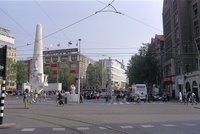 Dutch culture may be totally different from your own, so it is good to know something about Dutch culture. The experience of cultural differences can be strange, but also enriching.
Dutch culture may be totally different from your own, so it is good to know something about Dutch culture. The experience of cultural differences can be strange, but also enriching.
Social space and interaction
Introducing yourself
One of the first things that you will notice, is that people do not always introduce themselves very well. On other hand, it is generally appreciated if you take the initiative to introduce yourself.
The three times kissing ritual
When you meet a person whom you do not know that well, you can just shake hands, and next time a simple "goeiedag" or "hallo" will do. But for good friends and family, there is the kissing-ritual. Ladies first give each other three kisses on the cheek (right-left-right). Then the men follow, kissing a lady three times on the cheek and shaking hands with the men. The same ritual starts all over again when you leave.However, beware that not everyone likes to be kissed. When in doubt, don't!
Talking and social space
The Dutch have a very direct manner of speaking, especially when expressing their opinions. Also, they tend to talk with very short pauses, so that you hardly have time to interrupt. This can sound very rude when you are not used to it.
You will also notice that Dutch people have a tendency to stand rather close to each other when standing in line. When this makes you feel unconfortable, just keep in mind that many Dutch people don't appreciate this either.
On the other hand, their personal social space is much wider and less intimate. Dutch people are rather reserved at first about their private life. But, once you get to know them better and they do discuss their personal lives, there are not many non-discussable subjects.
Phone callsIn Holland it is considered rude not to say your name when answering the phone, or when making a phone call.Liberated womenIn Holland women do not have to be accompanied by a man to go somewhere. Therefore, men can not assume that girls are interested when they are alone. Their casual style of dress and interaction are considered normal in Dutch culture and they should be treated with respect.
Social Visits
Appointments
Dutch people in general do not like unexpected visits. Beware that they may want time to prepare themselves for the occasion. When you want to visit them at home, it may be a good idea not drop by just like that, but to call first.
You will notice that Dutch people, use their "agendas" (diaries) quite a lot. In general it is not necessary to re-confirm appointments. Moreover, as long you haven't cancelled, Dutch people will assume that the appoinment still stands, even if it was made long ago. So, they will expect your visit at the time and date agreed.
Wait to be served
When you visit them at their homes, it is polite to wait to be served. After the first serving, they will probably encourage you to help yourself, and then it is OK to do so, but it may not be appreciated if you are too forward.
Even most of the time at parties like birthdays, it is customary that the host serves the guests. So, when Dutch people visit you, do not forget to offer a second round of drinks, because they may not help themselves.
Gifts
When you come for a visit at someone's house it is appreciated if you bring a gift, e.g. wine, flowers or chocolates. This is also appreciated on other occasions such as parties and birthdays. Gifts are generally small and not lavish, except for family or good friends. The receiver opens the gift immediately.
Gezellig & Gezelligheid
A typical Dutch word indicating a warm atmosphere is the word gezellig. Translating the Dutch words gezellig en gezelligheid could be done with the words 'cozy' and 'coziness'. But the meaning is more intense than the word 'cozy' expresses. To the Dutch the word refers to a warm and amicable atmosphere in which everybody is cheerful and happy.
Sport events
There are some typical Dutch events, where the Dutch people celebrate or commemorate events. Also, there are some events and festivities that will make Holland and the normally reserved Dutch people go crazy.
Soccer
Sports are very important to us, especially soccer. Every major city has its own team: Ajax (Amsterdam), PSV (Eindhoven) and Feyenoord (Rotterdam) have gained international fame. Dutch society virtually shuts down during World Cup events, while the population literally paint themselves and their surroundings orange (the colour of the Royal House).
Skating
Another favourite sport is skating. Not only are we proud of our famous skaters. During a cold winter, all Dutch people will go crazy. That is because during a really cold winter, everyone looks forward to The Elfstedentocht, if it takes place.The Elfstedentocht
An 11-city marathon on ice, covers a course of almost 200 kilometres. From town to town huge numbers of spectators brave the cold to cheer the thousands of skaters. Leeuwarden, the capital of Friesland, has always been the start and finish.
For the 11-city marathon to actually happen, the ice needs to be at least 15 centimetres thick, covering virtually the whole route! From 1909 this has only happened 15 times. The last Elfstedentocht took place in 1997.Only those skaters finishing within the maximum excess time of 20% of the time posted by the male/female winner are eligible for an 11-city cross. Non-competitive skaters must arrive in Leeuwarden before midnight.FestivitiesCarnivalCarnival is an annual celebration. This is done predominantly in the south because of the large Catholic population there. Usually, it is somewhere in February and preludes Lent. The festivities last from the Friday until the Tuesday before Ash Wednesday. Nowadays, it is a feast of funny costumes and a lot of boozing, thus the link with the Catholic tradition is practically zero.
Queen's day (Koninginnedag)On April 30 the Queen's birthday is celebrated. On that day all kinds of festivities take place like markets and concerts. Many streets are coloured orange (the colour and the family-name of the Dutch Royal Family) and flags are put up. The night before Queen's day is called Koninginnenacht (Queen's night). That night there are big parties in Amsterdam and The Hague.
Remembrance Day & Liberation Day (Dodenherdenking & Bevrijdingsdag)On May 4 (Dodenherdenking) we commemorate those who lost their lives during World War II. At 20.00 hrs there is a two minute silence.
On May 5 (Bevrijdingsdag) we commemorate the liberation of the Netherlands from the German occupants during World War II. This is celebrated with pop festivals in various cities.
St. Nicholas' Birthday (Sinterklaas)
On December 5 Sinterklaas' birthday is celebrated. Three weeks before this date, he arrives in the Netherlands from Spain on his steamboat. From that day on the children can place their shoe near the chimney and receive candy and small presents. Sinterklaas is accompanied by his assistants called zwarte pieten (black petes). Only the good children are rewarded with presents, the naughty ones were, as it was said, taken in the bag of zwarte piet to Spain or hit with a rod. Sinterklaas knows all the children and has a list of children and their deeds in a old book which he brings along.
For the adult the birthday is celebrated in another fashion: they give each other so-called surprises (gifts hidden in funny self-made wrappings) accompanied by funny, home-made poems.
Cuisine
Dutch dishes are not regarded as especially famous; however, there are some warm and hearty meals ideal for cold temperatures.
Stamppot
The basic Dutch winter dish is, of course, stamppot (hotchpotch). There are several types of stamppot. In general, it consists of of mashed potatoes mixed with a vegetable, like saurkraut or or another type of cabbage, and rookworst (Dutch smoked sausage).
Hutspot
This is a hearty vegetable stew traditionally made of mashed potato, carrots and onions.
Erwtensoep and Bruinebonensoep
Other typical winter Dutch delicatessens are soups: bruinebonensoep (brown bean soup) and the famous Dutch erwtensoep (pea soup).
Herring
Herring is a real Dutch speciality. Eaten raw, pickled herring, covered with finely chopped onions and frequently served with a soft white roll, is a favourite in-between snack. The traditional way to eat herring is to hold it by its tail, tilting your head backwards and letting it slide into your mouth.Fast Food
The Dutch love to eat french fries. They are called friet or patat ("frietje" or "patatje"). The Dutch eat their frietjes with mayonnaise, they called it frietje met or frietje speciaal with a combination of mayonnaise, curry sauce and onions or frietje oorlog with a combination of mayonnaise, curry sauce, spicy peanut butter sauce and onions. Other variations exist as well. Another classic is the kroket (croquettes are a deep-fried snack with a soft meat-based filling eaten with bread and mustard).
Snackbars
These and many other snack food products can be bought at so-called snackbar, and, for even more convenience, from counters outside fast food restaurants. These snacks are fast, cheap and efficient (but not too healthy).
Home Cooking Meals
Most Dutch people cook their own meals and eat at home. Going out for dinner is mostly seen as a sort of special occasion. And a hot dinner is generally only eaten in the evening.
Breakfast
Usually consists of fresh bread, rolls, croissants with butter and jam and, of course, some nice Dutch cheese. Something typical to eat are Dutch rusks (beschuit) topped with hagelslag (chocolate sprinkles).
Lunch
Usually includes again sandwiches and cheese, a bowl of soup, fruit, a kroket or an uitsmijter (two fried eggs on two slices of bread with cheese and ham/roast beef). A glass of milk or karnemelk (buttermilk) is the usual lunch time drink.
Dinner
Normally, the Dutch only eat one hot meal per day. It can be served for lunch, but usually for dinner. A traditional evening meal consists of a main boiled vegetable, meat and a good serving of potatoes (boiled). The typical dessert (toetje) would be flavoured yoghurt or vla (slightly similar to custard), fruit or cheese.
Drinks
During the meals, drinks usually consist of water, milk, orange juice or soft drinks. Wine and beer are saved for going out to dinner or special occasions.
Source and more information: Welcome to Holland
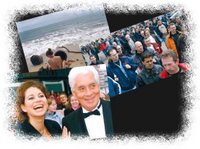 Reading newspaper in the train on the way to the Indonesian Embassy The Hague, and found three kind of sorrow which intrigued me...
Reading newspaper in the train on the way to the Indonesian Embassy The Hague, and found three kind of sorrow which intrigued me...
A western tourist on the quiet beach of Kuta-Bali. The United States and Australia have warned their citizens living or on holiday in Indonesia of a possible terrorist attack.
Disappointed NedCar employees on the way to home. Dutch car-making unit NedCar is expected to fire thousand of the 3000 jobs in a reorganization.
Frédérique Huydts, the beautiful great Dutch actress died on the age of 38 as a result of the Cancer.Source: METRO Nederland 04-04-2006
 Name at birth: Vivian Mary Hartley
Name at birth: Vivian Mary Hartley
Born: 5 November 1913
Birthplace: Darjeeling, India
Died: 7 July 1967Best Known As: Scarlett O'Hara in Gone With the Wind
Vivien Leigh didn't make many films, but she made movie history with her portrayal of Scarlett in Gone With the Wind (1939, opposite Clark Gable). Vivien's chances of getting the role of Scarlett O'Hara was not unexpected and probably non-existent, but fate stepped in, and a legend was born. For this role Vivien won her first Oscar.
One of a classical dialogue I don't forget, classic scene on the same hilltop where Mr. O'Hara once told Scarlett: "Ah, it'll come to you--this love of the land. You can't get away from it, if you're Irish," and Scarlett, now starving and filthy, finds an old radish buried in the ground, and she digs it up with her filthy fingernails and eats it with dirt still on it, and then she is ashamed, and she looks up into the triumphant sunset, and she declares:"AS GOD IS MY WITNESS, I'LL NEVER BE HUNGRY AGAIN."
The most magnificent picture ever!….
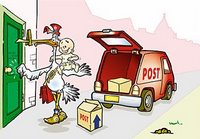 Little baby sleeping in the cradle snug and cosy. You are welcome to this world, another Grand Child joins the family, the most precious thing in the world that you could love and share.What an excitement. The Aunties and the Uncle were equally elated. Phone calls were made heralding Armyn's birth. Cheers in the waiting room. Cheers on the phone. Over and over we each shared the excitement of Armyn’s birth with those who could not be there.
Little baby sleeping in the cradle snug and cosy. You are welcome to this world, another Grand Child joins the family, the most precious thing in the world that you could love and share.What an excitement. The Aunties and the Uncle were equally elated. Phone calls were made heralding Armyn's birth. Cheers in the waiting room. Cheers on the phone. Over and over we each shared the excitement of Armyn’s birth with those who could not be there.
It was the beginning of a new era. Life as we knew it would never be the same. My little girl was now a mother. She and Joris now had a son to love and raise, Armijn, a beautiful baby boy....
 Holiday has come. The beloved holiday. Yes I'm off for a well-deserved holiday, will be going to Indonesia for five weeks.
Holiday has come. The beloved holiday. Yes I'm off for a well-deserved holiday, will be going to Indonesia for five weeks.

















